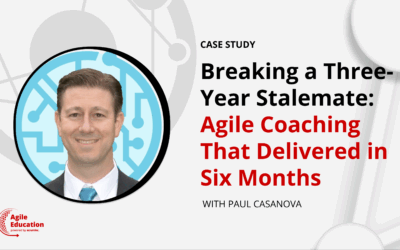Agile Education Case Study
From Missed Deadlines to Agile Success: Transforming Digital Media with Scrum@Scale
Hear how Mohammed Rowther led a successful Scrum@Scale transformation at a major digital media company facing many challenges, including missed deadlines and an outdated waterfall model. By implementing behavior-driven development, creating cross-functional feature teams, and introducing executive-level alignment workshops, Rowther significantly improved delivery times, collaboration, and customer satisfaction. The transformation resulted in an 80% increase in delivery speed, more accurate targets, and a more motivated workforce, demonstrating the power of Scrum@Scale in overcoming organizational hurdles.
CASE STUDY SNAPSHOT
Trainer Name: Mohammed Rowther
Industry: Software Development
Organization Size: Large
Topic: Agile Practice, Cross-Team Coordination, Delivery and Velocity, Executive Action Team (EAT), Prioritization
Date: 2019
Website: https://www.efficientagile.com/
LinkedIn: https://www.linkedin.com/in/mohammedrowther/
Case Study
Summary: From Missed Deadlines to Delivery Success
When Mohammed Rowther first began work with a large digital media company focused on releasing a new generation TV and mobile app, challenges were plentiful. The organization was utilizing a waterfall model, missed deadlines were common, team sizes were large (12-15 members on average), and meetings and stand ups consistently ran long. Additionally, teams weren’t focused on delivery, they were losing targets, and there was a lack of collaboration and communication.
Approach and Challenges
To start, Registered Scrum@Scale Trainer™ Mohammed Rowther began with a Behavior Driven Development process and the Scrum Repair Guide to get processes back where they needed to be. Initially, he created Feature Teams with 5-7 members across different work streams with a shared business analyst and Product Owner. In addition, coaches were brought in to train team members and empower teams to navigate through issues. Next, Mohammed introduced Scrum Master clinics to improve the quality of Scrum and facilitation across the teams. Finally, a Scrum of Scrums was created and an Executive Action Team was formed that included directors and executives. The entire process was working very well for those implementing it, but to scale the success within the company, there were four remaining challenges to work on.
Challenge #1: Setting Product Backlog Priorities with C-Level Executives
To address challenge #1, Mohammed created a two-day workshop to help executives prioritize epics and user stories in order to determine value to customers. To help categorize by importance, items were rated as Must Have, May be an Option, and Not Sure. Once finished, executives were very pleased with their well-defined product backlog as a starting point for the teams.
Challenge #2: Creating a Reference Model
Next, in order to create a reference model, they focused on bringing developers and testers together, implementing in-Sprint testing, and in-Sprint automation. They focused on working on small stories in sequential order. Testing throughout the Sprint resulted in more stories being done by the end of the Sprint.
Challenge #3: Collaboration between Product Owners and Business Analysts Took Time
In order to increase collaboration, business Analysts (technical experts) were paired with Product Owners (product experts) for story mapping sessions. As a result, gaps were discovered sooner, issues were resolved more quickly, and more small stories were ready by the end of each Sprint, helping the teams build a sense of momentum. The aim of this collaboration was to hone in on common goals, focusing on business value and avoiding personal priorities.
Challenge #4: Resistance from non-Agile Teams
Last, to address resistance from non-Agile teams and in the hopes of incorporating them into this model, Mohammed created a “Why Agile” workshop. This workshop focused on organizational goals – high performance, team collaboration, quality products – and how Agile could help them achieve these goals. Non-Agile teams were invited to act as “observers” alongside Agile Teams who shared their experience, and coaching, mentoring, and training was offered across the various teams. In the end, 50% of the organization’s teams were utilizing the model.
Results from Implementing Scrum@Scale
As a result of Mohammed’s Scrum@Scale transformation:
- 80% increase in delivery time
- Reduced team sizes (5-7 per team on average)
- Targets and deadlines became accurate
- Business and technical gaps resolved
- Decreased time to value
- Team collaboration increased
- Cross team collaboration problems resolved
- Motivation increased
- Customer satisfaction increased due to value added
About Mohammed Rowther
Registered Scrum@Scale Trainer™ Mohammed Rowther is an Agile Consultant with more than 21 years of experience in the IT industry. He is also an SPC SAFe 5 Consultant, Certified Scrum Professional (CSP), Certified Agile Leader (CAL), ICAgile Coach, and is currently serving various clients across the UK/Europe. He has supported several organizations in Agile Transformation, fostering better culture, mindset shift, building high-performance teams, and implementing Agile scaling frameworks like SAFe, Nexus, DAD, LeSS, Spotify Model and Scrum@Scale.
More Scrum@Scale Case Studies
Breaking a Three-Year Stalemate: Agile Coaching That Delivered in Six Months
Agile Education Case Study Breaking a Three-Year Stalemate: Agile Coaching That Delivered in Six Months A Private Equity (PE) platform initiative at a boutique Managed Fund Administration firm had stalled for three years due to cultural resistance, framework...
Turning Skepticism Into Success: Solventum’s Agile Transformation of HDM
A Data-Led Approach to Scaling Scrum Globally at Sanofi
Agile Education Case Study A Data-Led Approach to Scaling Scrum Globally at Sanofi How do you align 50+ global teams to deliver faster, smarter, and at scale? Sanofi’s mRNA Center of Excellence turned to a data-led Agile maturity framework to replace subjective...



